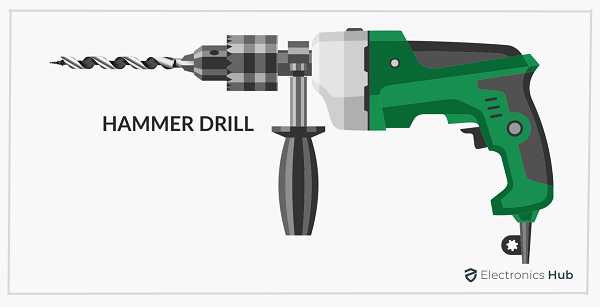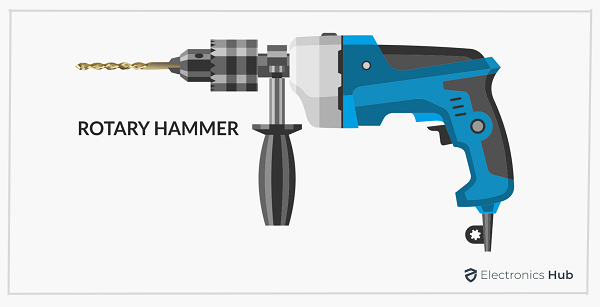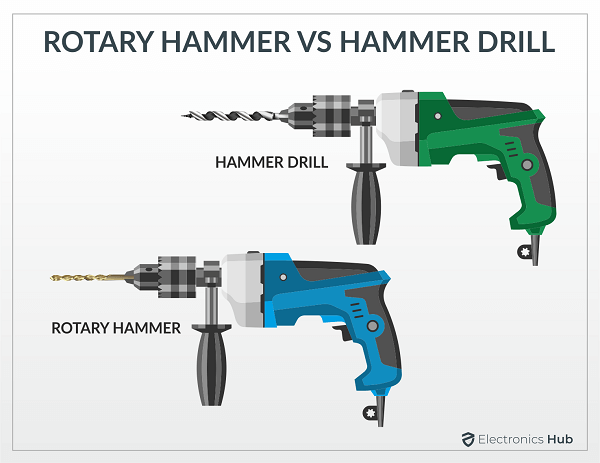If your work involves drilling holes in concrete or brick walls, then you need a proper power tool for the job. While regular electric drills with appropriate drill bits can make holes in concrete, you have two special tools that are designed specifically to work with concrete (or other tough materials). They are Hammer Drills and Rotary Hammer. If you are not familiar with these tools and are looking to purchase a “tough” tool, then will be in a dilemma on which tool to choose for your construction work or DIY Project. To help you out, we are making this essential Rotary Hammer vs Hammer Drill comparison guide.
In this guide, we will understand the basics of both Hammer Drills and Rotary Hammers along with their working. We will take a look at the differences between Rotary Hammer and Hammer Drill.
After that, we will make a Rotary Hammer vs Hammer Drill comparison against some important characteristics, specifications, workings and also their differences.
Outline
ToggleWhat is a Hammer Drill?

You can drill holes in wood, metal, and sometimes in brick with the help of an electric drill. Now, take the regular drill and make it slightly powerful so that drilling holes in brick, concrete or any masonry becomes very easy. It is nothing but a Hammer Drill.
In addition to rotating the drill bit, the Hammer Drill, as the name suggests, exerts a “hammering” or “reciprocating” action on the drill bit. As a result, the Hammer Drill applies a pounding action on the bit and makes the process of drilling holes in masonry very easy.
Working of a Hammer Drill
The working of a Hammer Drill is very simple. Internally, the chuck has two gears or metal discs with ridges facing each other. One disc (or gear) is attached to the shaft of the chuck while the other disc is stable.
When you switch on the hammering action, the discs engage with each other and the ridges on the discs will make the chuck reciprocate forward and backward. This mechanism is the basis of the hammering action.
While we see rotations per minute for a regular drill, we also see impacts per minute (IPM) or Blows/Beats Per Minute (BPM) for a hammer drill. This number indicates the number of times the drill bit hammered the surface.
We mentioned earlier that the hammer drill performs the hammering action only after we turn it on. What does this mean? It means most Hammer Drills in the market nowadays have the ability to switch between regular drill mode and hammer mode.
In regular drill mode, the internal ridges don’t come into play and you can Hammer Drill as a simple drill to make holes in whatever surface you want (wood, plastic, MDF, or metal).
As soon as you engage the hammer mode, the ridges come to life and create a lateral vibration of the chuck. These vibrations result in a hammering action and hence you use the hammer drill to make holes in cement, concrete, brick walls, or another tough masonry.
What is a Rotary Hammer?

Similar to a Hammer Drill, the Rotary Hammer also does two things at the same time i.e., it rotates the bit and also applies a hammering action on it. But how it does this job is what makes the Rotary Hammer different.
In the Hammer Drill, we saw a ridge mechanism that engages upon selecting the “hammer” mode to initiate the hammering action.
Working of Rotary Hammer
But in a Rotary Hammer, there is a cylinder and a piston. A motor drives the piston up and down in the cylinder and this movement of the piston creates air pressure.
The high-pressure air is then applied to the “hammer” mechanism to make it reciprocate and create the blow action on the bit. So, the Rotary Hammer converts the electric power into reciprocating pneumatic power to drive the piston and produce the hammering action. The high-impact hammering action of the Rotary Hammer pulverizes the material and helps in faster drilling action.
An important difference between a Hammer Drill and a Rotary Hammer is the number of impacts they produce. While Hammer Drills can apply more than 10,000 impacts per minute, rotary hammer usually does this in the region of 5,000 impacts per minute.
Even though the number of blows or impacts is less, the force of the impact is significantly large. As a result, drilling or boring holes in thick concrete is a breeze for Rotary Hammers. Some experts say that a Rotary Hammer is up to 10 times more powerful than a similar-sized Hammer Drill.
Differences: Rotary Hammer vs Hammer Drill

1. Size
Hammer Drills are very similar to regular electric drills (corded or cordless). There is no special design element or compartment to house the hammering mechanism. From the previous discussion, it is clear that adding two or three additional parts (gears or metal discs with ridges) behind the chuck makes it a hammering drill.
So, there is no significant change to the size of the Hammer Drill when compared to a Regular Drill. The Pistol grip style Hammer Drills are not that heavy when compared to a Rotary Hammer.
Coming to Rotary Hammer, it is a heavy tool (both in terms of performance and weight). There is a special “hammering” mechanism in the Rotary Hammer that occupies space and weight. As a result, the physical size and weight of a Rotary Hammer are much more than that of a Hammer Drill.
2. Hammering Action
The important and obvious difference between the two is how they produce the hammering action. Hammer Drills use a couple of gears (or metal discs with ridges) to create the vibrations and hammering action. So, the hammering mechanism is a part of the rotation mechanism.
This means you cannot use the hammering mode without the bit rotating. The hammering action in a Rotary Hammer has its special set of elements. It contains a drive mechanism (a bunch of gears) that pulls and pushes a piston. There is also a cylinder that houses the piston and acts as a chamber for compressed air.
As the hammering mechanism and the rotation mechanism are separate systems, most Rotary Hammers have the option to operate in drilling mode only, hammering mode only, or a combination of the two.
3. Chuck and Drill Bits
If you are familiar with electric drills and drivers, then you might know about the three-jaw adjustable chuck. Even Hammer Drills use a similar chuck. The drill bits for Hammer Drills are regular masonry bits with carbide tips.
But things get interesting with Rotary Hammer. They don’t use the same chuck as the Hammer Drills. They use a special type of “chuck” known as a Slotted Drive System or SDS.
It is a spring-loaded mechanism with two main types: SDS-Plus and SDS-Max. Of these two, the SDS-Plus Chuck is very popular and is suitable for hole size diameters in the range of 5/8-inch to 3/4-inch.
The SDS-Max on the other hand is slightly bigger as you can get them in the hole sizes of 3/8-inch to 2-inch.
Another interesting thing about Rotary Hammers is the size of the drill bit is related to the size of the chuck. That’s right. You need individual chucks for different drill bit sizes. Also, SDS-Plus bits will fit only in SDS-Plus chucks and SDS-Max bits fit only in SDS-Max Chucks.
The bits of the Rotary Hammer (SDS-Plus or SDS-Max) are masonry bits with carbide tips and they have groves on the shank. This helps in securing the bit to the chuck in a better way and also withstand the intense vibrations and hammering actions.
The design of the SDS chuck (movable collar) allows the SDS Bits to reciprocate freely without involving the chuck. This is why the separate rotation and hammering mechanisms work simultaneously.
4. Power
The impact of a Rotary Hammer is very high when compared to the impact of a Hammer Drill. As a result, you can drill into concrete very quickly using a Rotary Hammer.
In a Hammer Drill, the harder the user applies pressure on the bit, the more impact it generates. In contrast, a Rotary Hammer has a special piston mechanism to create the hammering action.
We can use a Hammer Drill on wood, metal, and even on concrete. But the high power of the Rotary Hammer makes it unusable on wood or metal.
Typical Electric Hammer Drills have a current rating of 6.5 Amps. But even small rotary hammers have a current rating of 13 Amps. These numbers alone tell you the power difference between the Hammer Drill and Rotary Hammer.
5. Additional Features
Rotary Hammers support a bunch of attachments other that regular drill bits. These attachments include tile removers, spades, and chisels. Of course, all these attachments have either SDS-Plus or SDS-Max style attachments to fit into respective chucks.
There are also special adapters that convert the SDS chuck into a three-jaw adjustable chuck. With this adapter, you can use regular bits with a rotary hammer.
6. Cost
Corded Electric Hammer Drills cost about $40 to $45. If you go for a cordless variant, then you have to spend $85 or more.
Rotary Hammers are expensive tools when compared to Hammer Drills. A 13 Amp Corded Electric Rotary Hammer costs about $120 to $125. If you want a cordless option, then the tool costs more than $290.
7. Applications
Hammer Drills are very versatile tools. You can use them to drill holes as well as drive fasteners. When you turn on the hammering action, you can make holes in masonry as well. But this is suitable only for occasional jobs.
You can use the Hammer Drill to make holes in masonry up to 1/4-inch in diameter. If you need a tool to make large holes or your job involves making several holes in concrete, then you are better off with a Rotary Hammer.
Using appropriate bits, you can make holes as large as 2-inch diameter. As you can use the Rotary Hammer in “hammer” only mode, you can use it as a demolition tool.
With attachments such as tile removes, you can use it to remove tiles as well.
Comparison of Rotary Hammer and Hammer Drill
Let us make a quick side-by-side comparison of Rotary Hammer vs Hammer Drill using the following table.
| Parameter | Hammer Drill | Rotary Hammer |
| Hammering Mechanism | Part of the rotating mechanism. Uses two gears (or metal discs with ridges) to create vibrations. | There is a special system that produces the hammering action. It consists of a piston and cylinder (with a gear drive) to create compressed air, which creates the reciprocation action. |
| Chuck | Standard three-way adjustable chuck. | Special spring-loaded SDS Chucks. |
| Drill Bits | Regular Carbide tipped Masonry Drill Bits | Carbide-tipped SDS Bits with special shank. |
| Size and Weight | Small and less weight than rotary hammers | Big and heavy tools |
| Power | Moderately powerful tools. You can drill holes in wood, metals, and even masonry. | Very powerful tools. Can make large holes quickly in thick concrete. |
| Applications | Occasional drilling jobs in concrete, regular holes on wood or metal, suitable for small hole sizes (up to 1/4-inch diameter). | Suitable for large holes up to 2-inch diameter in concrete. You can make the holes very quickly compared to hammer drills. Not recommended for wood or metal. |
| Cost | Corded electric hammer drills cost about $45, while cordless tool is $85. | A corded electric Rotary Hammer costs about $120 while a cordless tool is close to $300. |
Which One to Buy, Hammer Drill or Rotary Hammer?
Let us now focus on the important question, “Which tool should I buy, a Hammer Drill or a Rotary Hammer?”.
If you are an electrician who drills holes occasionally, then you can get away with a simple Hammer Drill. But if you drill holes daily and if the number of holes is more than a few, then we recommend you get a decent Rotary Hammer. It makes the process of drilling holes in brock walls, cement, or concrete very easy.
As we mentioned earlier, a Hammer Drill is more than enough to make holes up to 1/4 inch in diameter. If you want to make larger holes, you need to get a rotary hammer.
The speed at which you want to drill the holes will also make a difference. The proper hammering action of the rotary hammer creates a huge impact while drilling or boring. Hence, they can make holes very quickly.
Conclusion
Whether you are an electrician or an installer, you need to make holes in walls, especially tough cement, brick, or concrete walls. For this, you have two important tools in the form of Hammer Drills and Rotary Hammers.
In this guide, we saw the basics of these two powerful tools. We also saw their workings and even listed out the differences between them.
After that, we compared Rotary Hammer vs Hammer Drill by considering some important parameters. Finally, we concluded the guide with a “buying guide” on which tool to choose.
We hope that this guide could help you understand the differences between a Hammer Drill and a Rotary Hammer. If you feel we missed something or want us to add anything, do let us know in the comments section. It will not only help us but even other readers.

